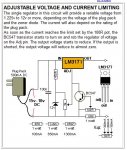I am going to use a 6 volt 1Ah sealed SLA battery in a project. I have no experience of charging these batteries, looked around but many larger Ah units out there and 12v not 6.
In looking I see people using the LM317 chip. I would ideally like the unit to top up the battery using an ADC pins monitoring on a 14M2.
At the moment I'm stuck, thinking maybe I should just have a socket for an external charger to plug in.
Trying to avoid a big bang, does anyone have a link to a suitable charger circuit.
Battery is Power Sonic PS-610 6 volt 1.0 Amp Hr.
http://www.ebay.co.uk/itm/6V-1AH-POWERSONIC-PS610-Rechargeable-Battery-for-UPS-toy-car-/201176691140?hash=item2ed710b1c4
In looking I see people using the LM317 chip. I would ideally like the unit to top up the battery using an ADC pins monitoring on a 14M2.
At the moment I'm stuck, thinking maybe I should just have a socket for an external charger to plug in.
Trying to avoid a big bang, does anyone have a link to a suitable charger circuit.
Battery is Power Sonic PS-610 6 volt 1.0 Amp Hr.
http://www.ebay.co.uk/itm/6V-1AH-POWERSONIC-PS610-Rechargeable-Battery-for-UPS-toy-car-/201176691140?hash=item2ed710b1c4




